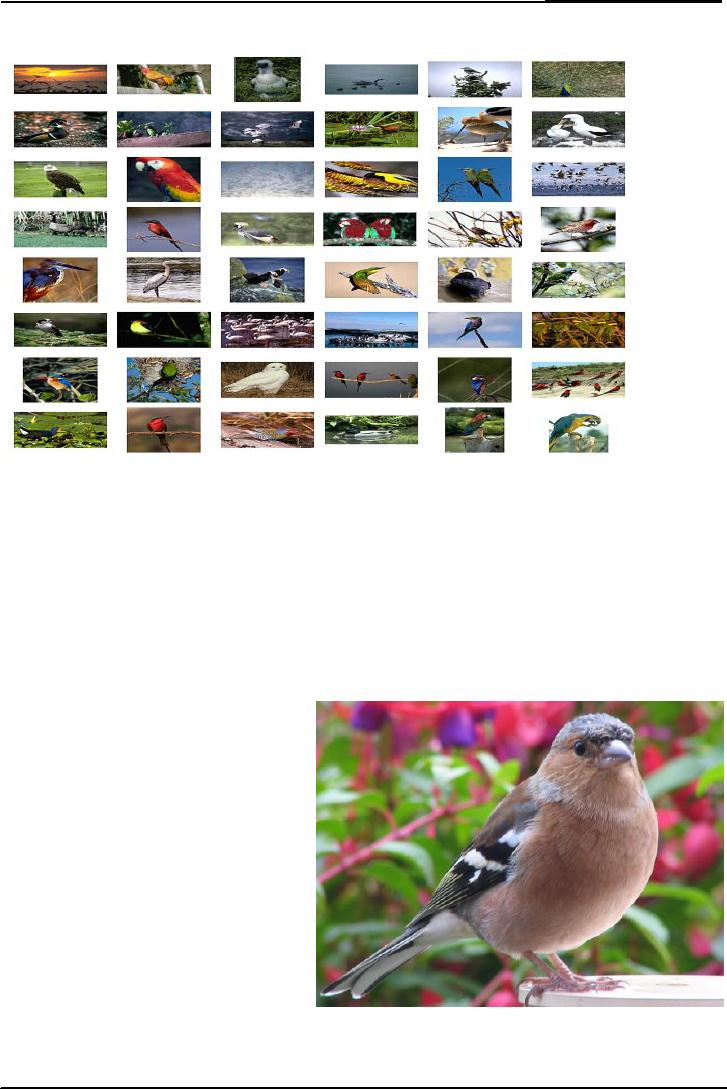 |
Memory:Benefits of Categorization, Levels of Categories |
| << Memory:Recognition of lost memories, Representation of knowledge |
| Memory:Prototype, Rosch and Colleagues, Experiments of Stephen Read >> |

Cognitive
Psychology PSY 504
VU
Lesson
34
Memory
Representation of
knowledge
Categories
Definition
of a category: "A category
refers to a group of objects
sharing the same
essential
features."
Benefits
of Categorization:
Categorization
reduces complexity of the
environment. Like example of
dog in previous
lecture.
There
are more than 7 million
discriminable colors. But we
can recognize in 7 colors. And we
call
almost
10, 0000 colors in one
category. We have many
categories of colors. For
example there
are
many shades of green colors,
like trees, parrot, etc
all having green colors
but they have
different
shades. Red colors also
have many shades like,
blood color rose color
etc.
Categorization
is means by which objects
are identified. For example
pattern recognition. Dog
is
a
category even there are
many kinds of dogs. If we
have never seen particular
object before but
we
can recognize it because of
its category.
Categorization
reduces the need for
constant learning. We don't
need to learn about the
new dog
but
we know this is dog because
it can bite and bark. No
need to learn about every
single object.
Because
we have learnt it
before.
Categorization
helps us decide appropriate
action. We have categorized
the thing that's why
they
are
easy to learn and remember.
For example we know about
the things whether they
are good
or
bad, poisonous or non-poisonous. We
know how to behave in front
of dog if the dog is
guard
dog,
or kept dog. So our response
is according to the
category.
Categorization
helps us order and relate
object. For example a
category of chair, there are
many
types
of categories like there
drawing room chair, kitchen
chair, kid's high chair,
dinning room
chair,
wheel chair. But the
category is chair we have
many sub categories. It
makes difference
and
allows us to make a hierarchy of
system that helps us ion
ordering and relating
things. Like
Chair,
highchair, furniture
Levels
of Categories
i)
Superordinate
Category:
"It
is a large category at the
top of the hierarchy." Such
as furniture, tools, vehicles
etc. furniture is
a
large category it has sofa,
bed, table, chair etc.
tool is also a large
category it has
electronic
tool,
wood tool etc. vehicles is
also large category. These
are subordinate
categories.
ii)
Basic
Level Category:
"It
is an intermediate category in the
middle of the hierarchy."
e.g. Table, chair, bed,
sofa etc. We
have
direct link with these
categories. These are basic
level because their
subordinate category
is
furniture.
iii)
Subordinate
Category:
"It
is a small category at the
bottom of the hierarchy."
e.g. lamp, screw-driver,
truck etc. screw
driver
is a specialized category. There
are many types of table
such as, coffee table,
lamp table,
etc.
another example is car like
100 cc car 800 cc car
etc.
We
can explain these three
levels in this way :
Level
1. Furniture
Level
2. Chair
Level
3. Drawing room chair
Concepts
100

Cognitive
Psychology PSY 504
VU
Definition:
"Concept
is a mental representation of a
category."
It
is the mental representation or is
the concept made up of the
rules regarding necessary
and
sufficient
features. Basically the
concept means what you
are getting in your head, is
it the
definition
of a chair?
How
the category is stored in
the mind is about a
concept.
A
botany student's concept of
fruit is slightly different
from that of the chef.
This is because they
get
this category in different
way. Both define fruit in
different way.
So
categories are internal
representation of categories.
Necessary
& Sufficient Features of
concept
It
is the mental representation or is
the concept made up of the
rules regarding necessary
and
sufficient
features.
What
is this mental representation
made up of?
For
example Furniture
Furniture
can be defined as Movable
articles in a building. This is
not a proper definition.
Every
definition
has many problems even in
this definition.
How
do you group chairs, tables
and sofas in furniture but
children's toys are
excluded?
Television?
May
be wooden articles
What
about metal sofas and
tables
Drawing
room, beds
Lamps
Lights
etc
These
all are movable
things.
We
can impose something in
categories. But in concepts we
can not. For example
science
students
can define Tomato and
Brinjal in different way but
lay man define it
different.
Mental
Experiment
A
mental experiment is to help in
understanding the
concept.
First
close your eyes,
What
comes to mind when I say
furniture?
Write
it down.
Now
again close your eyes,
what comes to mind when
someone say chair?
Is
it a definition? Or is it an example. It
means when you close
your eyes what comes in
your
mind
the definition or actual
image of chair at particular
place.
Prototypes
Proto
means "essential or basics"
when we make new things
first of all we make a proto
that
explain
briefly the new
things.
101

Cognitive
Psychology PSY 504
VU
Typical
features are averaged to
make a mental representation.
This unique representation
may
not
match a single
instance.
Look
in the above figures there
are many birds.
For
example we watch many birds
we note all features and
then take average of all
features. For
example
some have long beaks
some have short beaks. By
averaging this we make an
average
beak.
It means by averaging all
things we make a mental
representation. What would be
a
prototype
of the concept furniture,
average table + chair? The
prototype of furniture by
averaging
of
sofa, bed, or chair then a
different thing will
become.
We
store information about
categories in a head in the
form of prototype is a problematic.
The
averages
of all birds will not be
representative.
If
we average the feature off
all things we nothing find
something proper. Like the
average of
eagle
and crow will be different
than the actual.
Exemplars
Concepts
are
represented
by
exemplars.
For example when we
close
our
eyes and think about a
bird then a
typical
bird such as sparrow is
recalled.
And
when we think about
furniture we
picture
a particular part of our
homes
and
see specific sofas, chairs
and
tables
etc".
These
all are exemplars. In the
above
figure
we are seeing a sparrow this
is
an
actual bird not an average
bird. So in
our
mind we see actual pictures
not a
average
picture.
102
Table of Contents:
- INTRODUCTION:Historical Background
- THE INFORMATION PROCESSING APPROACH
- COGNITIVE NEUROPSYCHOLOGY:Brains of Dead People, The Neuron
- COGNITIVE NEUROPSYCHOLOGY (CONTINUED):The Eye, The visual pathway
- COGNITIVE PSYCHOLOGY (CONTINUED):Hubel & Wiesel, Sensory Memory
- VISUAL SENSORY MEMORY EXPERIMENTS (CONTINUED):Psychological Time
- ATTENTION:Single-mindedness, In Shadowing Paradigm, Attention and meaning
- ATTENTION (continued):Implications, Treisman’s Model, Norman’s Model
- ATTENTION (continued):Capacity Models, Arousal, Multimode Theory
- ATTENTION:Subsidiary Task, Capacity Theory, Reaction Time & Accuracy, Implications
- RECAP OF LAST LESSONS:AUTOMATICITY, Automatic Processing
- AUTOMATICITY (continued):Experiment, Implications, Task interference
- AUTOMATICITY (continued):Predicting flight performance, Thought suppression
- PATTERN RECOGNITION:Template Matching Models, Human flexibility
- PATTERN RECOGNITION:Implications, Phonemes, Voicing, Place of articulation
- PATTERN RECOGNITION (continued):Adaptation paradigm
- PATTERN RECOGNITION (continued):Gestalt Theory of Perception
- PATTERN RECOGNITION (continued):Queen Elizabeth’s vase, Palmer (1977)
- OBJECT PERCEPTION (continued):Segmentation, Recognition of object
- ATTENTION & PATTERN RECOGNITION:Word Superiority Effect
- PATTERN RECOGNITION (CONTINUED):Neural Networks, Patterns of connections
- PATTERN RECOGNITION (CONTINUED):Effects of Sentence Context
- MEMORY:Short Term Working Memory, Atkinson & Shiffrin Model
- MEMORY:Rate of forgetting, Size of memory set
- Memory:Activation in a network, Magic number 7, Chunking
- Memory:Chunking, Individual differences in chunking
- MEMORY:THE NATURE OF FORGETTING, Release from PI, Central Executive
- Memory:Atkinson & Shiffrin Model, Long Term Memory, Different kinds of LTM
- Memory:Spread of Activation, Associative Priming, Implications, More Priming
- Memory:Interference, The Critical Assumption, Limited capacity
- Memory:Interference, Historical Memories, Recall versus Recognition
- Memory:Are forgotten memories lost forever?
- Memory:Recognition of lost memories, Representation of knowledge
- Memory:Benefits of Categorization, Levels of Categories
- Memory:Prototype, Rosch and Colleagues, Experiments of Stephen Read
- Memory:Schema Theory, A European Solution, Generalization hierarchies
- Memory:Superset Schemas, Part hierarchy, Slots Have More Schemas
- MEMORY:Representation of knowledge (continued), Memory for stories
- Memory:Representation of knowledge, PQ4R Method, Elaboration
- Memory:Study Methods, Analyze Story Structure, Use Multiple Modalities
- Memory:Mental Imagery, More evidence, Kosslyn yet again, Image Comparison
- Mental Imagery:Eidetic Imagery, Eidetic Psychotherapy, Hot and cold imagery
- Language and thought:Productivity & Regularity, Linguistic Intuition
- Cognitive development:Assimilation, Accommodation, Stage Theory
- Cognitive Development:Gender Identity, Learning Mathematics, Sensory Memory